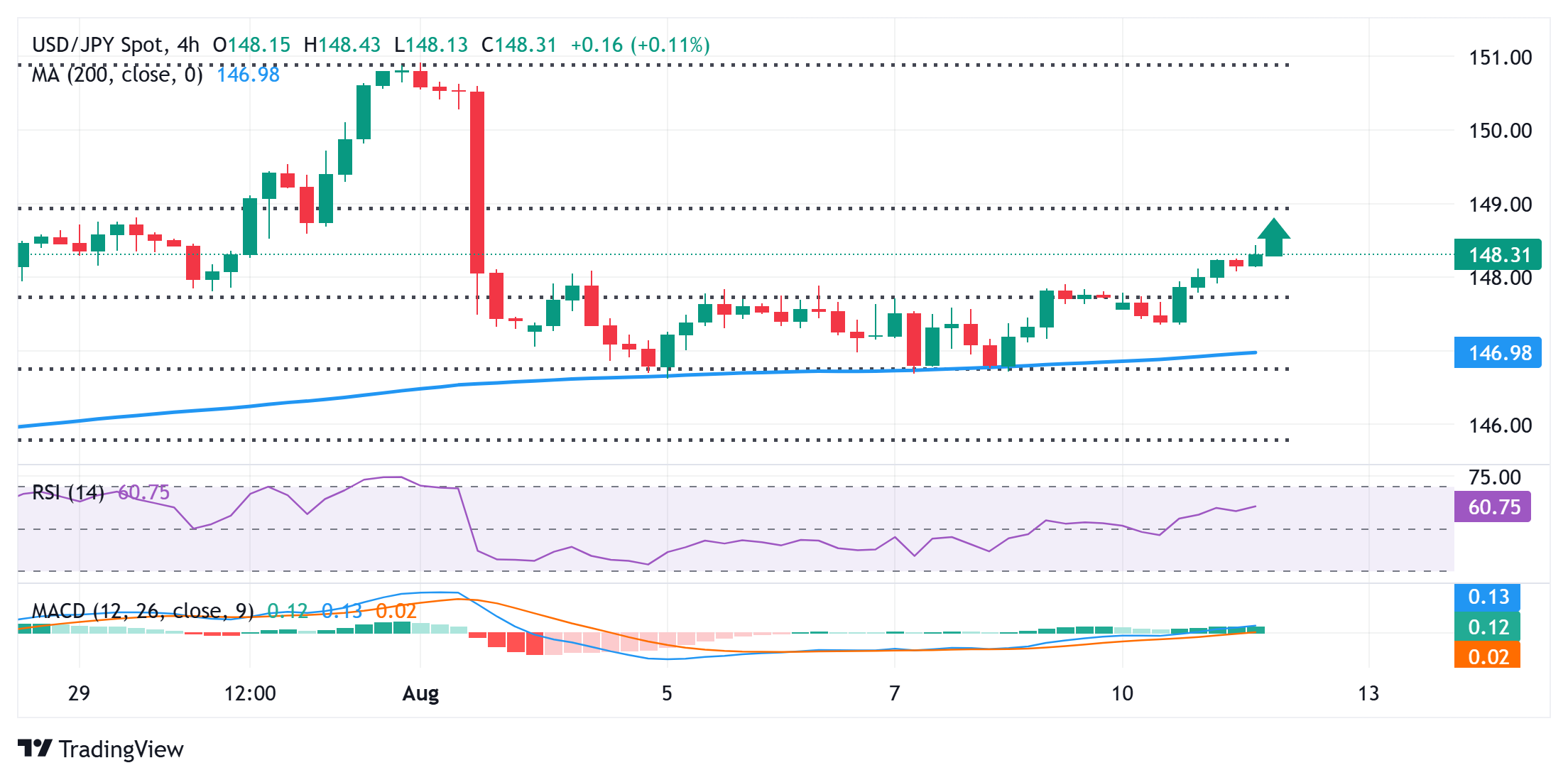- The Japanese Yen remains depressed amid mixed BoJ rate hike cues and a positive risk tone.
- However, the divergent BoJ-Fed policy expectations keep a lid on further gains for USD/JPY.
- Traders also seem reluctant and opt to wait for the release of the US consumer inflation data.
The Japanese Yen (JPY) maintains its offered tone through the Asian session on Tuesday and lifts the USD/JPY pair to over a one-week high, closer to mid-148.00s in the last hour. Investors now seem convinced that the prospects for further policy normalization by the Bank of Japan (BoJ) could be delayed further amid domestic political uncertainty and the potential negative impact of higher US tariffs on the economy. This, along with the underlying bullish sentiment, continues to undermine the safe-haven JPY.
Meanwhile, the BoJ revised its inflation forecast at the end of the July meeting last week, and reiterated that it will raise interest rates further if growth and inflation continue to advance in line with its estimates. This marks a significant divergence in comparison to dovish Federal Reserve (Fed) expectations, which caps the US Dollar (USD) and could support the lower-yielding JPY. Traders might also opt to wait for the release of the US inflation figures, which will drive the USD demand and provide a fresh impetus to the USD/JPY pair.
Japanese Yen selling remains unabated as upbeat market mood undermines safe-haven assets
- Data released last week showed that inflation-adjusted real wages in Japan fell for the sixth straight month in June and fueled concerns about a consumption-led recovery. This comes on top of growing worries about Japan’s fiscal health amid calls from the opposition to boost spending and cut taxes, especially after the ruling Liberal Democratic Party’s loss in the upper house election on July 20.
- Investors appeared to largely shrug off the latest tariff escalation, which is evident from the underlying bullish tone around the global equity markets. This further contributes to the safe-haven Japanese Yen’s relative underperformance against the US Dollar for the third consecutive day on Tuesday and lifts the USD/JPY pair to a one-and-a-half-week high during the Asian session.
- The BoJ’s Summary of Opinions released last Friday showed that policymakers debated the likelihood of resuming interest rate increases. Furthermore, the BoJ had revised up its inflation outlook in July, and reiterated that it will hike interest rates further if growth and inflation continue to advance in line with its estimates. This, in turn, might hold back the JPY bears from placing aggressive bets.
- Traders are overwhelmingly betting that the US Federal Reserve will resume its rate-cutting cycle in September and deliver at least two 25-basis-point rate cuts by the end of this year amid signs that the economy could be weakening. The expectations were lifted by the disappointing release of the US Nonfarm Payrolls report, which showed that employers hit the brakes on hiring in July.
- This, in turn, fails to assist the US Dollar to capitalize on its gains registered over the past two days and acts as a headwind for the USD/JPY pair. Traders also seem reluctant and keenly await the release of the latest US consumer inflation figures, due later during the North American session. The crucial data would influence Fed rate-cut expectations and, in turn, drive the USD demand.
- Investors will further take cues from speeches by influential FOMC members, which should provide some meaningful impetus to the USD/JPY pair. This week’s economic docket also features the release of the US Producer Price Index on Thursday and the Preliminary Q2 GDP print from Japan on Friday. This could further infuse volatility around the USD/JPY pair during the latter part of the week.
USD/JPY constructive setup backs case for further gains towards reclaiming the 149.00 mark

The overnight breakout through the 147.75-147.80 hurdle (38.2% Fibonacci retracement level of the July upswing) and a close above the 148.00 round figure could be seen as a key trigger for the USD/JPY pair. Moreover, slightly positive oscillators on the daily chart suggest that the path of least resistance for spot prices is to the upside. Some follow-through buying beyond the 148.45-148.50 region will reaffirm the constructive outlook and lift the pair towards the 149.00 neighborhood, or the 23.6% Fibo. retracement level.
On the flip side, the 148.00 mark, followed by the 147.80-147.75 region, could offer immediate support to the USD/JPY pair. Any further decline could be seen as a buying opportunity near the 147.00 round figure and remain limited near the 146.80 confluence – comprising the 200-period Simple Moving Average (SMA) on the 4-hour and the 50% Fibo. retracement level. A convincing break below the latter, however, might prompt some technical selling and drag spot prices to sub-146.00 levels, or the 61.8% Fibo. retracement level. The downward trajectory could extend further and eventually drag the pair to the 145.00 psychological mark.
Japanese Yen FAQs
The Japanese Yen (JPY) is one of the world’s most traded currencies. Its value is broadly determined by the performance of the Japanese economy, but more specifically by the Bank of Japan’s policy, the differential between Japanese and US bond yields, or risk sentiment among traders, among other factors.
One of the Bank of Japan’s mandates is currency control, so its moves are key for the Yen. The BoJ has directly intervened in currency markets sometimes, generally to lower the value of the Yen, although it refrains from doing it often due to political concerns of its main trading partners. The BoJ ultra-loose monetary policy between 2013 and 2024 caused the Yen to depreciate against its main currency peers due to an increasing policy divergence between the Bank of Japan and other main central banks. More recently, the gradually unwinding of this ultra-loose policy has given some support to the Yen.
Over the last decade, the BoJ’s stance of sticking to ultra-loose monetary policy has led to a widening policy divergence with other central banks, particularly with the US Federal Reserve. This supported a widening of the differential between the 10-year US and Japanese bonds, which favored the US Dollar against the Japanese Yen. The BoJ decision in 2024 to gradually abandon the ultra-loose policy, coupled with interest-rate cuts in other major central banks, is narrowing this differential.
The Japanese Yen is often seen as a safe-haven investment. This means that in times of market stress, investors are more likely to put their money in the Japanese currency due to its supposed reliability and stability. Turbulent times are likely to strengthen the Yen’s value against other currencies seen as more risky to invest in.







